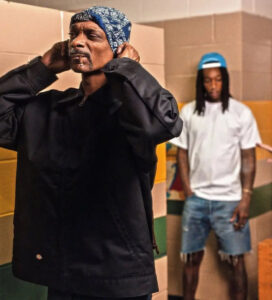In the ever-unfolding narrative of American hip-hop, few figures command longevity and cultural gravity like Snoop Dogg. From his G-funk genesis in Long Beach to his transformation into a multimedia mogul and mentor, Snoop has redefined what a rapper can be. Now, with Iz It a Crime: The Movie, Snoop trades in his mic for a director’s chair—without ever putting the mic down. This project isn’t just a film. It’s a signal flare in the foggy future of hip-hop storytelling, blending music, cinema, noir, and memoir into a new kind of cultural artifact.
Let’s be clear: this isn’t your average music video, nor is it a traditional film. Iz It a Crime is a hybrid experiment—a fusion of narrative filmmaking and visual album, drenched in West Coast grit and seasoned with Snoop’s unmistakable sense of cool. Think Belly meets Menace II Society with a splash of Tarantino’s pulp and a heavy dose of hip-hop realness. It’s not just a movie—it’s a statement.
The Premise: Crime, Conscience, and Consequences
The title—Iz It a Crime—asks a loaded question. Is survival a crime? Is ambition? Is revenge? Snoop’s story follows a protagonist shaped by the streets, caught between past loyalties and present stakes. The plot unfolds like a classic noir: shadowy, moral ambiguity laced into every choice, every betrayal.
There’s a woman. There’s a setup. There’s a score to settle. But more than that, there’s an undercurrent of emotional honesty: regret, paranoia, bravado, and vulnerability braided into one man’s journey through a world where the rules change mid-game.
Snoop taps into a well-worn genre and flips it. The streets aren’t glamorized—they’re mythologized, then deconstructed. What emerges is a film soaked in tension and silence as much as dialogue and beats. It’s about the weight of reputation, the cost of power, and the myth of escape.
Visual Language and Aesthetic
Stylistically, Iz It a Crime is lush and textured. It’s a throwback, but it’s also ahead of the curve. The film leans into a neo-noir aesthetic: saturated reds and greens, slow pans, cigarette smoke curling in dimly lit rooms. Cinematographer-style shots frame Snoop like a ghost from a better past—or a boss in full control.
Every visual choice is deliberate. There’s a rhythm to the pacing, a musicality to the editing. It’s film as mixtape—scenes cut like bars, transitions like beat drops. The camera lingers where others would cut. Silence isn’t empty—it’s loaded. Every frame implies more than it says.
And then there’s the wardrobe. The styling is impeccable. Suits like armor. Chains like trophies. Everything drips with intent: power, nostalgia, warning.
Soundtrack as Backbone
This film doesn’t work without the music—and that’s the point. Iz It a Crime plays like a visual album, where each track pushes the story forward. Songs don’t just score scenes—they are scenes. The soundtrack bleeds through every frame, turning inner monologues into verses and shootouts into lyrical meditations.
Snoop’s voice is the anchor—sometimes narrating, sometimes rapping, sometimes just present. Other artists slide in and out like ghosts: collaborations from contemporary heavyweights and veterans alike. Each track is tailored to its moment: menace, heartbreak, betrayal, epiphany. This isn’t just background music—it’s the emotional scaffolding.
Snoop’s bars here are different too. More reflective. Less stuntin’, more storytelling. These aren’t flexes. They’re confessions.
Hip-Hop Noir: A Genre Emerges
What Iz It a Crime arguably inaugurates is a new subgenre: hip-hop noir. It’s not just a music video gone longform or a rapper trying to act. It’s something else entirely. It builds on precedents—films like Paid in Full, Juice, New Jack City—but pushes further into introspection and meta-awareness.
This genre understands that the gangster persona has worn thin in some places—but its psychological impact hasn’t. Hip-hop noir doesn’t just show the life. It shows the consequences. It’s gritty not for shock, but for depth.
And it’s also a challenge to the industry: to stop treating music videos like throwaways and start using them as a cinematic language. It’s a dare: tell better stories, build layered characters, treat visual media with the same reverence as the booth.
Snoop the Auteur
One of the most striking elements of Iz It a Crime is Snoop himself—not just as star, but as author. He’s not coasting on fame here. He’s orchestrating, arranging, crafting. This is a passion project, not a vanity project. There’s vision behind it, and that vision is personal.
Snoop is no longer trying to prove he’s a great rapper. He’s trying to show he’s a storyteller—and a director of culture. And it works.
His choices are bold. He allows ambiguity. He lets scenes breathe. He resists exposition. He shows restraint where other projects would lean on spectacle. This isn’t a greatest hits reel. It’s a tone poem with teeth.
It also reflects Snoop’s evolution as a man. Gone is the 19-year-old Long Beach provocateur. In his place is a man who’s seen it all, survived it all, and still has something to say. Iz It a Crime is not just a question for the character. It’s a question for the audience—and maybe for Snoop himself.
Cultural Commentary
Beneath the stylish grime and cinematic sheen, Iz It a Crime is making commentary: on race, power, masculinity, and trauma. The film speaks in code, in metaphor, but it’s saying real things.
It’s about Black legacy—how it’s built, how it’s stolen, how it haunts. It’s about cycles of violence not just as street reality, but as inherited script. It’s about reputation as currency, and how identity can become both shield and cage.
And crucially, it’s about performance. How men—especially Black men in hip-hop—perform toughness, loyalty, invincibility. Iz It a Crime interrogates those performances. What happens when the mask slips? What happens when the bullets stop flying and silence sets in?
Snoop doesn’t offer neat answers. He just leaves the smoke hanging in the air.
Imperfections and Grit
Is the film flawless? No. There are rough edges. Some acting stretches thin. A few scenes linger too long, or don’t fully connect. But those imperfections feel lived-in, almost necessary. This isn’t a polished studio flick. It’s street gospel—raw, unfiltered, true to itself.
The film’s flaws are part of its authenticity. It doesn’t aspire to be a slick Hollywood product. It wants to feel real. Not in the documentary sense, but in the emotional sense. You may not remember every plot twist, but you’ll remember the tone. The feeling. The mood.
Legacy and Innovation
What Iz It a Crime ultimately offers is a blueprint. A map for future artist-filmmakers who want to move beyond brand-building and into myth-making. This is not a product—it’s a provocation.
Snoop Dogg has already made his mark in music. This is something else. This is legacy work. This is risk. And that’s what makes it exciting.
In a culture saturated with content, Iz It a Crime stands out because it doesn’t beg for views. It demands attention. It’s not trying to “go viral.” It’s trying to last.
This is the kind of project that inspires film students and bedroom emcees alike. It’s a call to elevate the art form. To remember that storytelling is still sacred. That visuals matter. That hip-hop still has stories worth telling.
Impression
Iz It a Crime isn’t just a film. It’s an idea. A vibe. A new frontier. Snoop Dogg, once again, proves that he’s not just riding trends—he’s setting them.
And maybe that’s the real answer to the film’s title question. Is it a crime to dream bigger? To push the culture forward? To defy the box the world puts you in?
If it is, then Snoop’s guilty as hell.
And we should thank him for it.
No comments yet.









